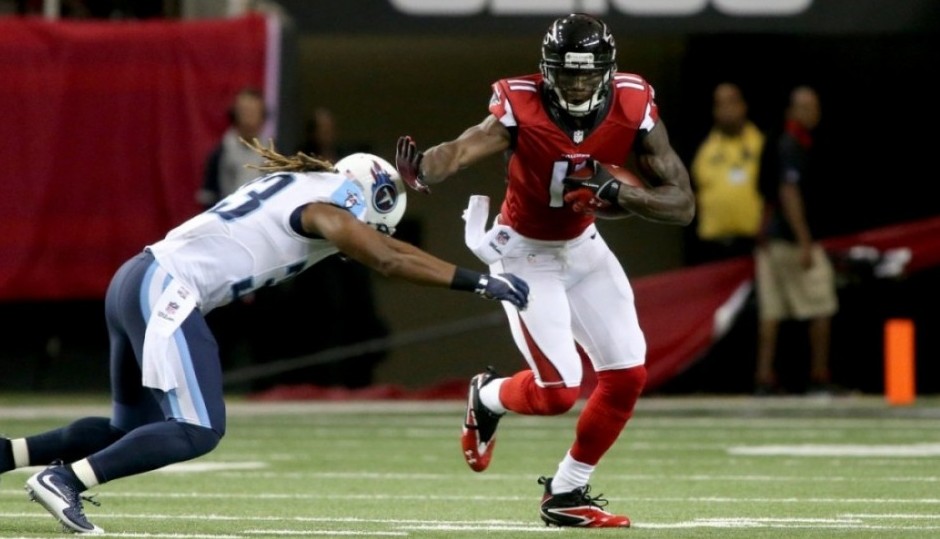Eagle Eye: Trying To Stop Julio Jones

Photo courtesy of USA Today Sports.
Walter Thurmond has faced Julio Jones once before. But four years later, Thurmond says he doesn’t remember the game very well. It might be selective memory.
On Oct. 2, 2011, the Falcons took on Thurmond’s Seahawks at CenturyLink Field. Jones torched the Seattle secondary for 11 catches and 127 yards en route to a 30-28 victory.
The other half of the Eagles’ safety duo, Malcolm Jenkins, remembers his matchups with Jones a little better than Thurmond does.
Jenkins faced Jones five times back when the two were division rivals, including when Jones caught eight passes for 128 yards and a touchdown against the Saints in his rookie season.
“Julio’s obviously one of the elite receivers in this league,” Jenkins said this week, “and has been, really, since he stepped in.”
When it comes to keeping the explosive wideout in check, Jenkins, the quarterback of the secondary, will have plenty of work to do. The veteran safety said Jones is difficult to cover because he possesses all three key traits of a great wide receiver—size, speed and strength.
Some wide receivers have just one, he said, and some will have two. But the elite pass catchers, like Jones, have all three.
“If you’re just a big receiver, we’re going to press and we’re going to push somebody in the face,” Jenkins explained. “Your size is then equalized. If you’re a fast receiver, we’ll keep deep coverage over top of you so that you can’t get the long bomb. We’ll force you to catch the ball underneath. If you’re just a quick guy, we’ll match up with a quick guy.
“The problem with Julio—and what makes him so good—is he’s got the speed, he’s got the size, he’s got the hands to catch in traffic, and when the ball’s in his hands, he’s like a running back. He’s strong at the point of attack. So that combination doesn’t give you the option to just beat him one way.”
For a few examples of what Jenkins is talking about, and what Thurmond reiterated, let’s take a look at a few plays during Jones’ games against Thurmond’s Seattle squad and Jenkins’ New Orleans team.
In this first play, which came against Jenkins’ Saints, cornerback Jabari Greer gets beat because of Jones’ size advantage. Greer plays off of Jones from the snap, and is able to keep up with him on the fly pattern. But when it comes time to make a play on the ball, Jones is simply too big for Greer, and he makes the catch.
Here, against Thurmond’s Seahawks, cornerback Brandon Browner decides to play tight at the line of scrimmage. Browner is initially in good position, but he doesn’t account for Jones’ speed. Jones takes the outside angle and gets a step on Browner, who is unable to turn fast enough to keep up with Jones.
In this third play, Jones flashes a little of the physicality Jenkins touched on. The receiver runs a 15-yard post and makes the catch around his own 40-yard line. He’s first contacted by a New Orleans defender around his own 45-yard line, but is able to shrug off the potential tackle and gain 15 extra yards.
There’s no sure-fire way to stop a wide receiver like Jones, or at least not one any team has found so far.
When he was in New Orleans, Jenkins’ defenses used several trial-and-error tactics.
“We always wanted to put somebody in his face, and if it got out of control early, we would double-team him,” Jenkins explained. “If not, we let whoever it was hold up. But the middle field safety has to always keep his eye on where No. 11 was, just because he’s that big of a threat.”
For Jenkins and Thurmond, the job is seemingly simple: keep Jones in front of you.
Whichever safety is playing the middle of the field, Thurmond explained, his job is “to stay deeper than the deepest player, and not let [Jones] get over top of my head, as far as running those post routes.”
Of course, it sounds a lot easier than it actually is.